
A Practical Guide to Choosing the Right Body Fridge for Storage
Why Proper Body Storage Matters for Your Facility
A body-fridge is a specialized refrigeration unit designed to preserve deceased bodies at controlled temperatures, typically between 2°C and 4°C (36°F-39°F), to slow decomposition and maintain dignity during storage. These units are essential equipment for funeral homes, hospitals, and forensic facilities.
Key Body-Fridge Essentials:
- Temperature Range: 2°C to 4°C for standard preservation, -10°C to -50°C for forensic applications
- Common Capacities: 1-20 bodies per unit, with modular options available
- Construction: Stainless steel interior (SS201/SS304) with polyurethane insulation
- Price Range: $2,600-$7,400 for standard 6-body units
- Power: Standard 220-240V with optional UPS backup systems
When someone passes away, decomposition begins within hours at room temperature. A quality body-fridge slows this natural process, giving you the flexibility to provide compassionate service while maintaining health and safety standards.
Modern body-fridge technology features independent temperature controls for each chamber, digital displays with alarm systems, and energy-efficient compressors that maintain precise temperatures for weeks or months. Whether you need a single-body unit for a small funeral home or a walk-in facility for a large hospital, the right body-fridge protects both dignity and public health.
I'm Mortuary Cooler, a national-level body-fridge supplier with extensive experience helping funeral homes and medical facilities select the right cooling solutions across all 48 contiguous states.
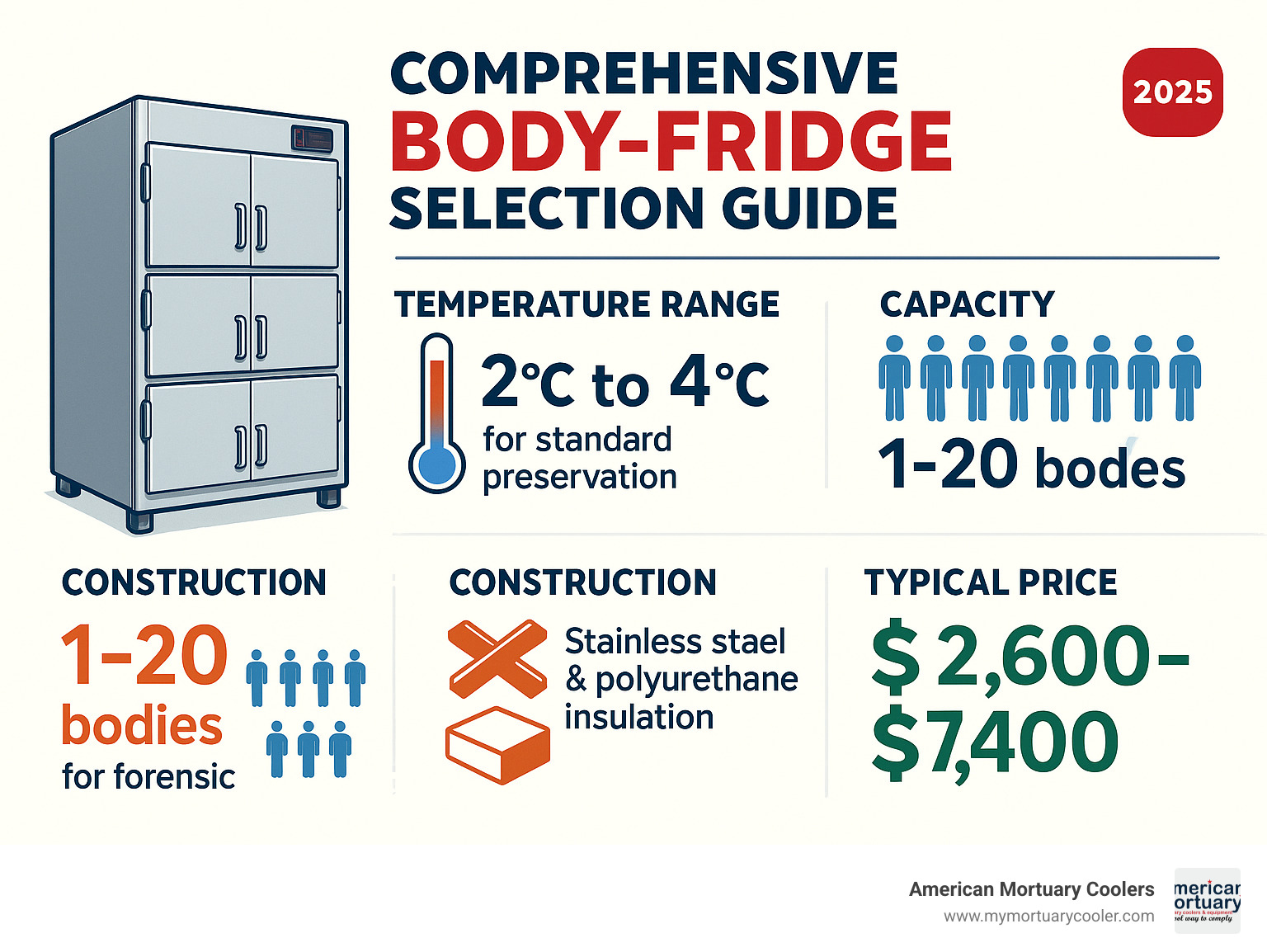
Quick look at body-fridge:
Why Temperature Matters Early
The human body maintains 98.6°F during life, but once death occurs, this warmth becomes a breeding ground for bacteria. Without proper refrigeration, decomposition accelerates rapidly. Bacteria multiply exponentially at room temperature, leading to tissue breakdown within hours.
Most states require maintaining body temperatures around 47-48°F during storage periods, particularly before cremation where waiting periods of 24-48 hours are common. Early cooling maintains dignity and provides families with the gift of time for meaningful arrangements.
Overview of Sections Ahead
We'll explore everything you need to know about selecting the right body-fridge for your facility. First, we'll examine the technology behind these specialized units and the various types available. Then we'll dive into technical specifications, cost considerations, and maintenance best practices.
Understanding Body-Fridge Technology
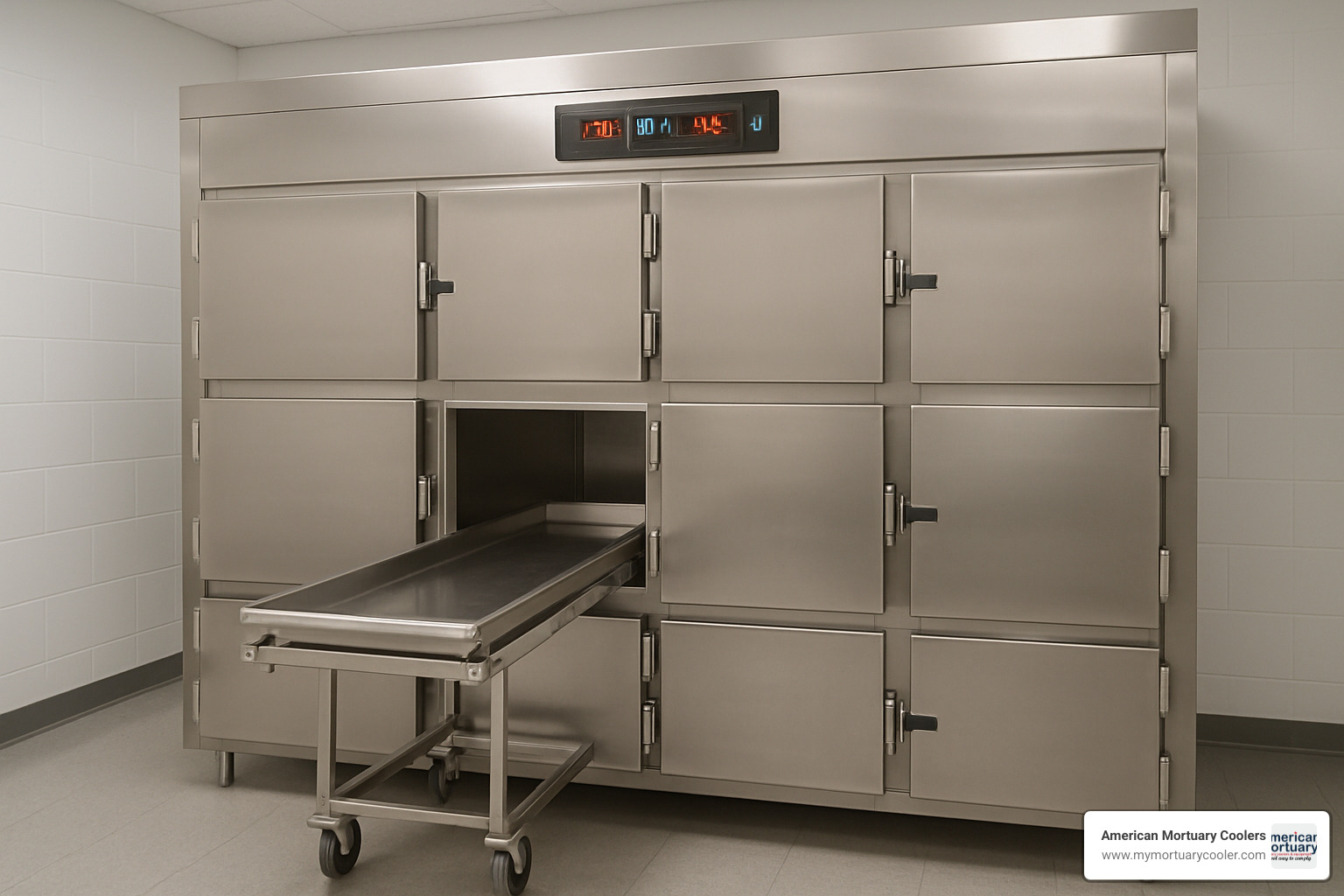
A body-fridge creates a carefully controlled environment that slows the biological clock that starts ticking the moment life ends. These specialized units maintain precise temperature control between 2°C and 4°C, where bacterial activity that drives decomposition slows dramatically.
What makes mortuary refrigeration different from standard refrigeration goes beyond size. These units manage moisture levels to prevent tissue damage, ensure proper airflow to eliminate hot spots, and maintain hospital-grade hygiene standards.
More info about Cold Comfort guide
What Is a Body-Fridge?
A body-fridge is purpose-built refrigeration equipment designed specifically for storing human remains. The primary mission is simple: preserve dignity while buying time for families to gather and make arrangements.
Hospital morgues and funeral home body-fridges serve similar purposes but with different priorities. Hospital units focus on efficient storage and quick access for medical procedures. Funeral home units emphasize individual care and accessibility for family services.
How a Body-Fridge Works
The refrigeration cycle uses a compressor to pressurize refrigerant gas, sending it to the condenser which releases heat and turns gas into liquid. The liquid passes through an expansion valve, rapidly expanding and cooling as it enters evaporator coils inside the storage chamber.
Modern digital thermostats constantly monitor and adjust to maintain accuracy within ±1°C of your target. Air circulation systems ensure cooled air reaches every corner of each chamber, preventing warm spots that could compromise preservation.
Body-Fridge vs Other Cold Units
Food freezers operate too cold (below 0°F) and can damage human tissue. Laboratory refrigerators lack the internal space, structural strength, and specialized features mortuary applications demand.
Body-fridge units feature 60-100mm of polyurethane foam insulation compared to about 40mm in regular refrigerators, providing better temperature stability, lower energy costs, and the reliability needed for preservation quality.
Types of Body Fridges & Applications
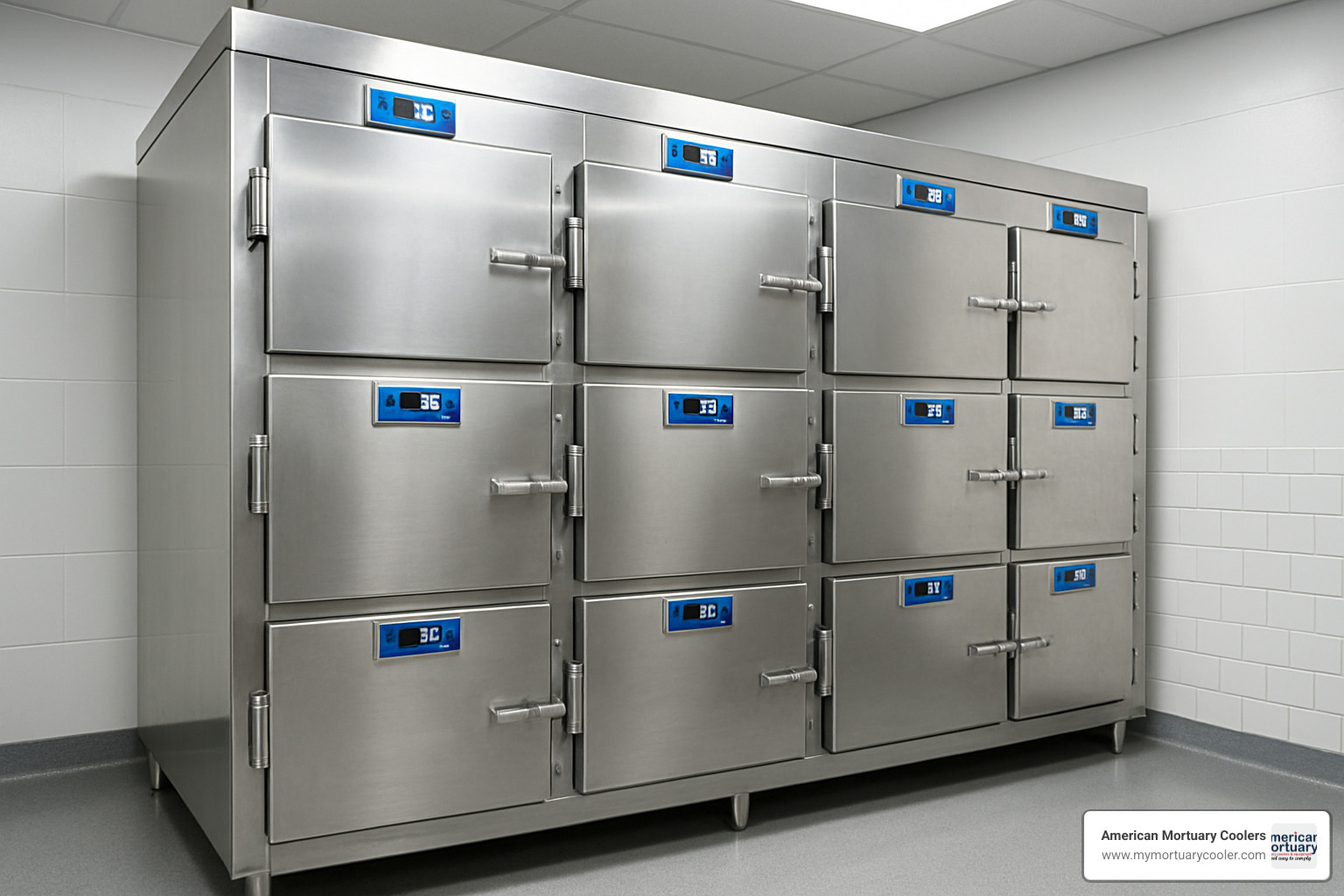
Choosing the right body-fridge depends on your facility's unique needs. Modular cabinets let you start small and grow as needed. Walk-in rooms maximize space efficiency for high-volume operations. Portable units provide flexibility for emergency response or temporary overflow.
Single-Body Body-Fridge Units
Single-body units work perfectly for small funeral homes where space is premium. These compact units typically measure 2460×800×610mm externally while providing 1950×630×440mm of internal space.
Most come with six heavy-duty wheels for mobility and plug into standard 220-240V power. The UPS backup power option provides essential protection during power outages, especially valuable for remote facilities or older buildings with questionable electrical systems.
Multi-Body Cabinets (2-20 Bodies)
Multi-body cabinets are the workhorses of mortuary refrigeration, featuring independent chambers with individual temperature controls. 2-body units cost $5,799-$8,500, 3-body units run $8,000-$12,000, popular 6-body units range $2,600-$7,400, and 9-body configurations cost $15,000-$25,000.
The modular design allows expansion as facilities grow. Individual compressors provide crucial redundancy - if one system fails, others keep running. Roller racks and telescoping slide rails make daily work safer and more dignified.
Portable & Mobile Body-Fridge Solutions
Portable units provide plug-and-play operation for emergency response, overflow capacity, or temporary storage during maintenance. They offer professional-grade refrigeration without major capital investment and can be relocated as needs change.
Walk-In Cold Rooms
Walk-in cold rooms handle 16-30 bodies simultaneously using panel construction with 4-inch thick polyurethane insulation. The larger thermal mass provides superior temperature stability while centralized refrigeration systems consume less energy per body stored.
Key Specs & Features to Evaluate
Getting specifications right ensures reliable operation for decades. Stainless steel construction using SS201 or SS304 grades, polyurethane foam insulation, and temperature ranges from -18°C to 10°C form the foundation of quality units.
Scientific research on corpse refrigeration
Temperature Control & Accuracy in a Body-Fridge
Professional body-fridge units maintain set-points between 1-5°C with accuracy within ±1°C through computer-controlled systems. Digital displays show real-time temperatures while data logging capabilities create permanent records for regulatory compliance.
Sub-zero options for forensic applications (-10°C to -50°C) can halt decomposition for extended storage during complex investigations. These units require improved insulation and more powerful refrigeration systems.
Construction Materials & Hygiene
Stainless steel construction provides essential durability and hygiene. SS201 grade offers good corrosion resistance at reasonable cost, while SS304 grade provides improved durability for high-use environments.
Seamless interior surfaces prevent bacterial contamination, rounded corners eliminate hard-to-clean spots, and high-quality magnetic gaskets create airtight seals that maintain temperature and reduce energy consumption.
Safety, Alarms & Compliance
Modern units include comprehensive audio and visual alarms monitoring temperature, power status, and door position. Remote monitoring capabilities send alerts to off-site personnel via phone or internet.
EISA 2007 compliance ensures energy efficiency, while UL-NSF certification verifies safety and sanitation standards. Auto-lock features balance security with accessibility, and odor filtration systems manage air quality.
More info about Morgue Fridge vs Body Fridge
Buying Considerations & Cost Breakdown
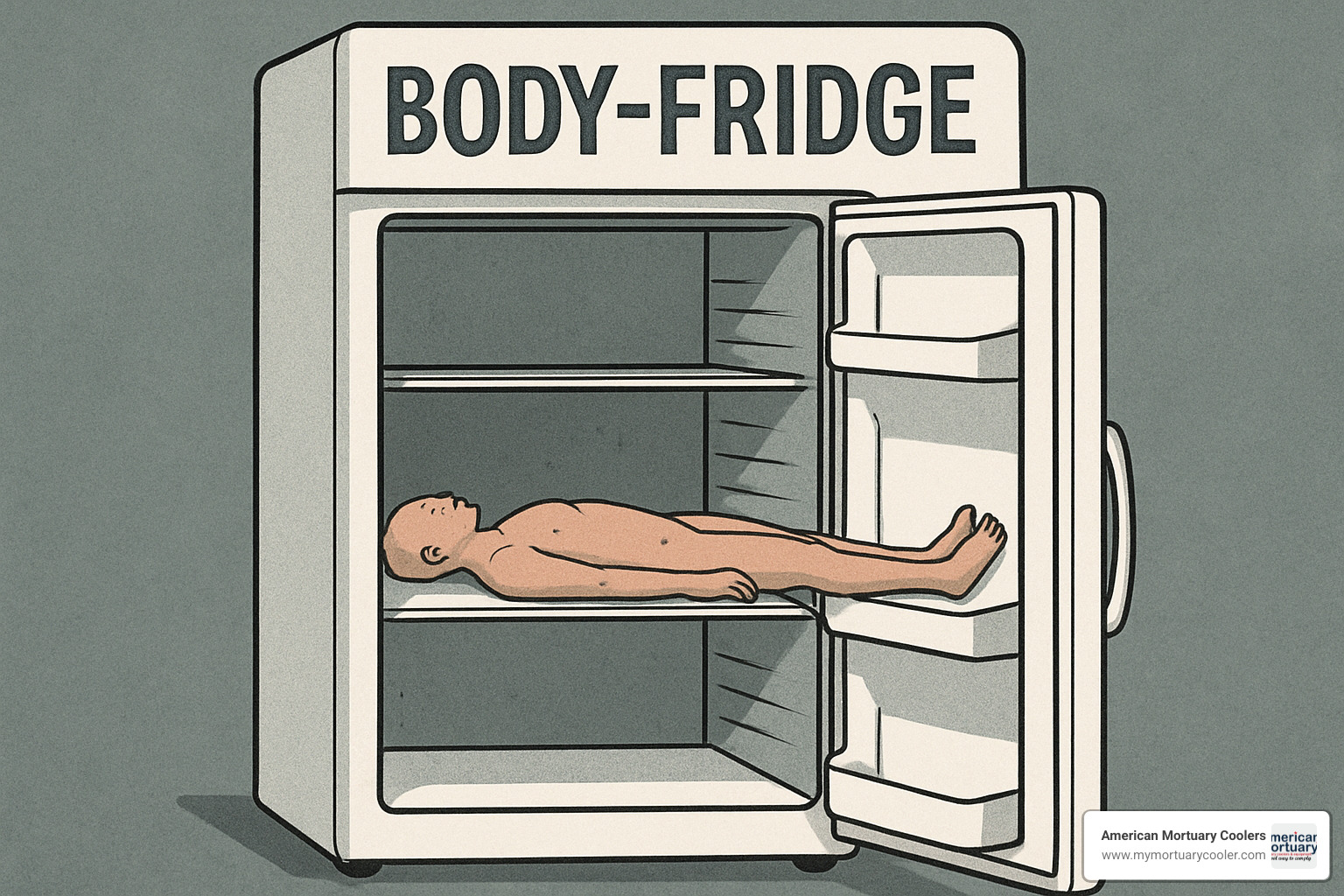
The sticker price of $2,600-$7,400 for a standard 6-body unit is just the starting point. Consider installation costs, ongoing energy bills, and maintenance expenses over 10-15 years of operation.
Smart planning starts with understanding actual needs. Plan for peak capacity, not just average occupancy. Consider space requirements, electrical capacity, and maintenance access during selection.
More info about Choosing a Body Storage Refrigerator
Regulatory & Public-Health Standards
Every state has specific rules about body-fridge requirements, including temperature ranges and record-keeping. Most modern units include automatic temperature logging that creates permanent records without extra staff work.
Green burial regulations are becoming more common. Since green burial prohibits embalming, refrigeration becomes the only preservation option, requiring equipment capable of longer storage periods.
Total Cost of Ownership
Energy costs are typically the biggest ongoing expense. Units costing $500 more upfront but saving $200 annually on electricity provide long-term savings. Warranty coverage varies between manufacturers - compare panel warranties and compressor coverage carefully.
Maintenance contracts provide predictable costs and professional care, especially valuable for facilities without technical staff.
Vendor Comparison Checklist
Lead times vary significantly - standard units ship in weeks while custom configurations take months. Many manufacturers offer OEM and ODM services for customization, though this increases costs and delivery time.
Trade assurance and financing options can smooth purchasing. At American Mortuary Coolers, we provide custom solutions with direct delivery across all 48 contiguous states, helping facilities find solutions that fit their space, budget, and operational requirements.
Maintenance, Safety & Emerging Trends
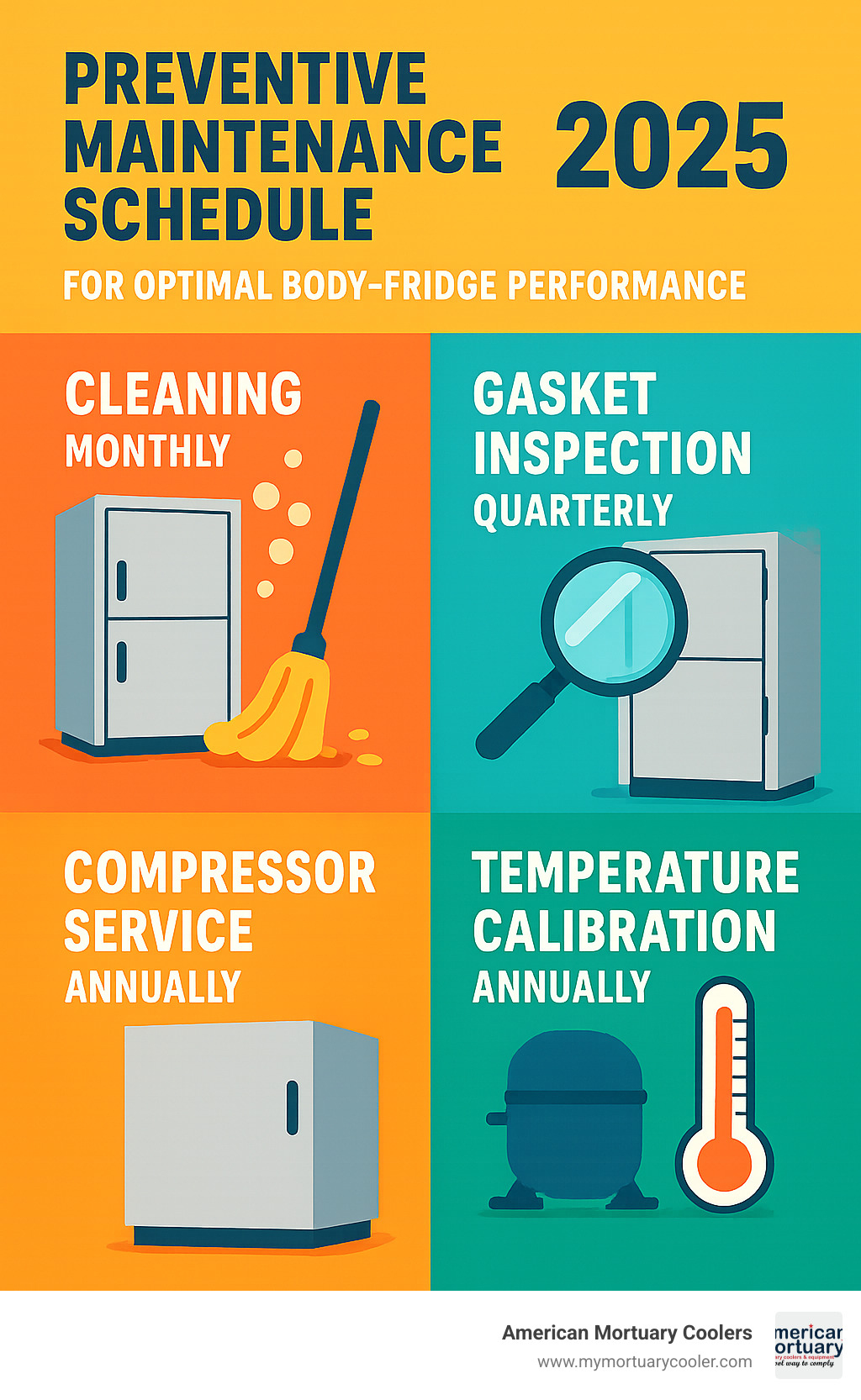
Proper maintenance protects families you serve and extends equipment life to 15-20 years. Modern body-fridge units are designed for easy maintenance, with most routine care taking just minutes daily.
The industry is evolving with innovations like UV sterilization systems, IoT monitoring, solar backup systems, and eco-friendly R290 refrigerants that reduce environmental impact while improving efficiency.
Routine Care for a Body-Fridge
Daily cleaning with standard sanitizers maintains hygiene - avoid harsh chemicals that damage finishes. After each use, thoroughly clean interior chambers, paying attention to corners and gasket areas where bacteria hide.
Monthly gasket inspections catch problems before expensive repairs. Look for cracks, tears, or lost flexibility. Compressor service every 6-12 months includes checking refrigerant levels, cleaning condenser coils, and calibrating temperature controls.
Future Innovations
Smart sensors track compressor vibration, temperature stability, and energy consumption to predict problems before failures occur. Remote monitoring provides phone alerts about temperature changes, power outages, or maintenance needs.
Eco-friendly refrigerants like R290 improve energy efficiency while being environmentally gentle. Solar backup systems ensure operation during power outages.
At American Mortuary Coolers, we stay current with innovations to help customers across all 48 states choose equipment that serves them well into the future.
Frequently Asked Questions about Body-Fridges
The most common questions from funeral directors, hospital administrators, and facility managers focus on practical concerns that affect family satisfaction and regulatory compliance.
How long can a body stay in a body-fridge?
Properly maintained body-fridge units can preserve bodies for weeks or months when needed. At standard temperatures of 2-4°C, most bodies maintain acceptable condition for 2-4 weeks without embalming.
Deep-freeze units at -20°C can preserve bodies for several months without significant deterioration. Key factors include how quickly refrigeration began after death, health condition at time of death, and exact temperature maintained.
Plan for 2-3 weeks with standard refrigeration, but equipment handles extended storage when circumstances require it.
What temperature should a body-fridge maintain?
For standard preservation, maintain temperatures between 2°C and 4°C (36°F-39°F). This range slows decomposition significantly without freezing and potentially damaging tissues.
Quality units maintain within ±1°C of your set point. Most state regulations require this range, proven by decades of mortuary science. Avoid running colder "to be safe" - temperatures below 2°C can cause tissue damage affecting preparation quality.
Do I need a negative-temperature unit for forensic cases?
Negative-temperature units are essential when you need to halt decomposition completely. Sub-zero temperatures of -10°C to -50°C stop biological processes entirely, critical for complex legal cases or extended investigations.
However, freezing can affect tissue quality for certain examinations. Consult with forensic pathologists about temperature requirements for typical cases. Many facilities maintain both standard and sub-zero units for maximum flexibility.
Conclusion
Finding the perfect body-fridge for your facility is really about one thing: ensuring you can provide dignified care when families need you most. Whether you need a single-body unit for a small funeral home or a walk-in cold room for a large hospital, the right equipment is available.
Today's units offer smart monitoring systems, energy-efficient operation, and precision temperature control. Features like IoT connectivity and eco-friendly refrigerants are becoming standard, not just nice-to-have options.
At American Mortuary Coolers, we've worked with facilities across all kinds of communities, from Tennessee mountains to busy New York hospitals. What strikes us most is how this equipment supports something bigger than preservation - it gives families the gift of time to gather, make thoughtful decisions, and say goodbye properly.
The death care industry keeps evolving, and so do the tools that serve it. Custom solutions are becoming more accessible, and our 48-state coverage means you don't compromise on service quality regardless of location.
Your body-fridge investment will serve your community for 10-15 years or more. That's thousands of families who will benefit from your thoughtful equipment choice today.



